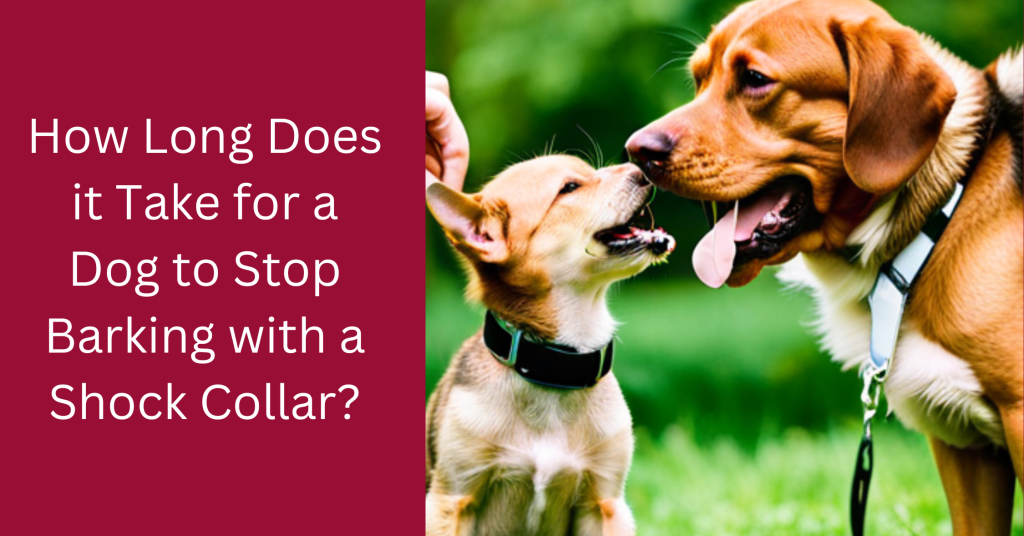
Shock collars are a popular tool used to train dogs not to bark excessively.
While they can be effective in reducing barking behavior, many pet owners wonder how long it takes for a dog to stop barking with a shock collar.
The answer to this question depends on several factors, including the individual dog’s behavior and the severity of their barking.
Some dogs may stop barking after just a few uses of the shock collar, while others may take several weeks of consistent use.
It is important to note that shock collars should only be used under the guidance of a professional dog trainer or veterinarian.
Additionally, it is important to use the collar in conjunction with positive reinforcement training to ensure that the dog learns the appropriate behavior.
In this article, we will explore the different types of dog collars to stop barking and their effectiveness in reducing excessive barking.
We will also discuss the proper use of shock collars and the importance of positive reinforcement training in conjunction with their use.
By the end of this article, pet owners will have a better understanding of how shock collars can be used to reduce barking behavior and how to use them safely and effectively.
How long does it take for a dog to stop barking with a shock collar?
The amount of time it takes for a dog to stop barking with a shock collar varies depending on the individual dog and the severity of their barking behavior.
Some dogs may stop barking after just a few uses of the collar, while others may take several weeks of consistent use.
It is important to note that while shock collars can be effective in reducing excessive barking, they should only be used under the guidance of a professional dog trainer or veterinarian.
Understanding Shock Collars
Shock collars, also known as electronic collars or e-collars, are devices that deliver a mild electric shock to the dog’s neck when they bark excessively.
The shock is meant to startle the dog and discourage them from barking.
It’s important to note that shock collars should be used as a last resort after other training methods have been exhausted.
The Training Process
The effectiveness of a shock collar in stopping excessive barking depends on several factors, including the dog’s temperament, motivation, and the training technique used. Every dog is unique, and their response to a shock collar may vary.
Some dogs may quickly learn to associate the shock with their barking and stop barking altogether, while others may take longer to respond to the training.
Gradual Training Approach
When introducing a shock collar to your dog, it’s crucial to take a gradual and humane approach.
The collar should never be used as a punishment tool but rather as a means to communicate to the dog that barking is unwanted behavior.
Here’s a step-by-step guide on how to train your dog to stop barking with a shock collar:
- Choose the Right Collar: Select a shock collar that is appropriate for your dog’s size and needs. Consult with a professional trainer or veterinarian to ensure you make the right choice.
- Proper Fit: Ensure the shock collar is properly fitted to your dog’s neck. It should be snug but not too tight. Read the manufacturer’s instructions carefully for guidance on fitting.
- Start with Low Intensity: Begin the training with the lowest intensity setting on the shock collar. The goal is to startle the dog, not cause pain or distress.
- Associate the Shock with Barking: Whenever your dog barks excessively, activate the shock collar. This will help the dog understand that their barking triggers the unpleasant sensation.
- Consistency is Key: Use the shock collar consistently whenever your dog engages in excessive barking. Consistency is crucial for the dog to make the connection between their barking and the shock.
- Positive Reinforcement: Alongside the shock collar training, reinforce positive behavior by rewarding your dog when they remain quiet or respond to a command.
- Monitor Progress: Keep track of your dog’s progress over time. Gradually reduce the frequency of using the shock collar as your dog learns to control their barking.
Individual Factors
It’s important to understand that every dog is different, and the time it takes for them to stop barking with a shock collar will vary.
Factors such as the dog’s temperament, previous training, and the severity of the barking problem can influence the training timeline.
Responsible Use of Shock Collars
While shock collars can be effective in curbing excessive barking, they should be used responsibly and as a last resort.
Here are some guidelines to ensure the humane and responsible use of shock collars:
- Consultation: Seek guidance from a professional dog trainer or veterinarian before using a shock collar. They can provide valuable insights and help tailor a training plan for your dog’s specific needs.
- Avoid Continuous Use: Shock collars should not be worn continuously. It’s recommended to limit the collar’s usage to specific training sessions or periods when excessive barking is likely to occur.
- Monitor Behavior: Keep a close eye on your dog’s behavior during and after training sessions. If you notice any signs of distress or negative effects, discontinue the use of the shock collar immediately.
- Combine Training Methods: Shock collars should be used in conjunction with positive reinforcement training methods. Reward your dog for good behavior and provide mental and physical stimulation to prevent boredom-induced barking.
- Regular Assessment: Periodically assess your dog’s progress and reevaluate the need for the shock collar. As your dog becomes trained to control their barking, you may be able to phase out the use of the collar.
Conclusion
Using a shock collar to address excessive barking in dogs can be effective when used responsibly and in conjunction with positive reinforcement techniques.
The time it takes for a dog to stop barking with a shock collar will vary depending on individual factors, training consistency, and the dog’s temperament.
Remember to prioritize your dog’s well-being and consult with professionals to ensure you’re using the shock collar in a humane and effective manner. With patience and proper training, you can help your dog become a quieter and happier companion.

